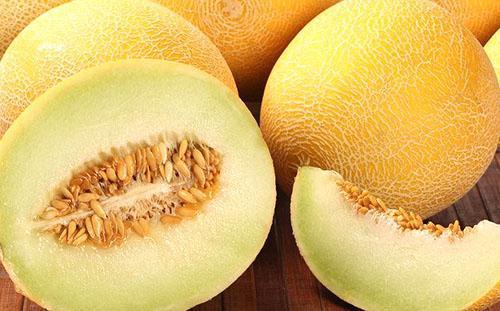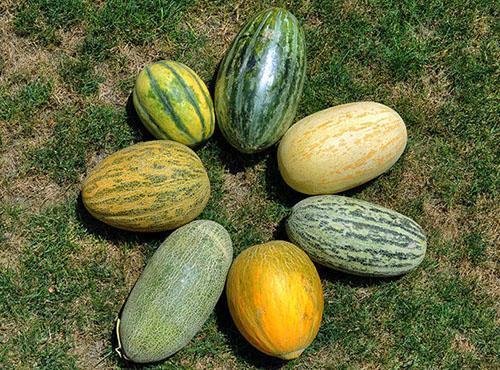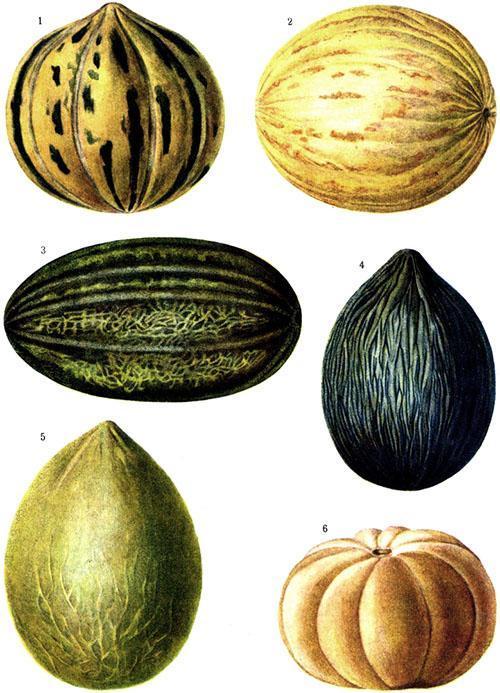To help summer residents, photos and names of different varieties of melons
 The homeland of the melon belonging to the pumpkin family is Asia. Here, in hot summer conditions, from Central Asia to the tropical regions of India, the largest number of cultivated and wild species of this plant in the world matures. The real center for the emergence of melons as an agricultural melon crop is the Central Asian region, Afghanistan, Iran and China and India.
The homeland of the melon belonging to the pumpkin family is Asia. Here, in hot summer conditions, from Central Asia to the tropical regions of India, the largest number of cultivated and wild species of this plant in the world matures. The real center for the emergence of melons as an agricultural melon crop is the Central Asian region, Afghanistan, Iran and China and India.
But it is unlikely that it will be possible to see the ancestor of the varieties and varieties of melon obtained to date. Over thousands of years of selection, cultural forms have become strikingly different from those growing to this day wild-growing species. And the increasingly large and sweet fruits of melons with trade caravans and troops of the Romans and other conquerors came to the north of Africa.
There is evidence that in European countries they learned about the existence of melon and its unforgettable taste only in the Middle Ages, and on the territory of Russia, for example, in the Volga region, melons brought from Persia and Central Asia were grown already in the 15th century.
Central Asian varieties of melons: names, photos and descriptions

In this case, the shape of the fruit can be completely different from flattened and spherical to elongated-ellipsoidal. The palette of colors on a smooth or mottled peel with small cracks is also surprising.
 The illustration shows varieties of melons with various shapes, skin color and consumer characteristics:
The illustration shows varieties of melons with various shapes, skin color and consumer characteristics:
- melon type kassaba;
- melon Bukharka or Chogare;
- Pineapple melon or Ich-Kzyl;
- melon kassaba Assan Bay;
- Charjui melon or Gulabi;
- melon cantaloupe.
Among the Central Asian varieties, there are summer-ripening melons that are ready to eat immediately after picking from lashes, and there are varieties that are kept fresh for at least 5-6 months and show their best qualities only next spring.
 Melons of the Kassaba variety type, in the photo the names of varieties of these melons can be seen under numbers 1 and 4, are also called winter melons, since their ripening begins extremely late.
Melons of the Kassaba variety type, in the photo the names of varieties of these melons can be seen under numbers 1 and 4, are also called winter melons, since their ripening begins extremely late.
 After harvest, the fruits are braided with reeds and hung in dry rooms or under sheds for aging and storage. Only by March does the tough greenish pulp become juicy and sweet.
After harvest, the fruits are braided with reeds and hung in dry rooms or under sheds for aging and storage. Only by March does the tough greenish pulp become juicy and sweet.
Melon Chogary, number 2, or, as it is more often called in Russian-speaking regions, Bukhara has thick white very sweet pulp and gives oval, with a slightly pointed end, fruits weighing up to 6 kg. Due to their high juiciness, these melons can rarely be found far from Central Asia, but here the variety is in demand and widespread.
 But the Gulyabi melon, pictured at number 5, is well known in the territory of the former USSR. Rarely does a plant manage to play a role in a feature film. This variety of Central Asian melon was lucky enough to appear in the film "Station for Two", albeit under a pseudonym. Everyone who watched this film remembers the alien melons sold by the main characters. In fact, there is no such variety, but the large, up to 3-5 kg in weight, egg-shaped fruits of Charju melons were well known in the Soviet Union.
But the Gulyabi melon, pictured at number 5, is well known in the territory of the former USSR. Rarely does a plant manage to play a role in a feature film. This variety of Central Asian melon was lucky enough to appear in the film "Station for Two", albeit under a pseudonym. Everyone who watched this film remembers the alien melons sold by the main characters. In fact, there is no such variety, but the large, up to 3-5 kg in weight, egg-shaped fruits of Charju melons were well known in the Soviet Union.
This variety, bred in the Chardzhui region of Turkmenistan, is distinguished by dense white pulp, sweetness, good keeping quality and transportability, therefore it is not surprising that fruits from the Uzbek or Turkmen SSR were brought by rail to the European part of the country even in late autumn.
 The third number in the photo is pineapple melon or Ich-kzyl, which gives medium-sized oval fruits. The mass of such a melon is from 1.5 to 4 kg. And although this summer variety was not familiar to a wide circle of melon growers and gourmets in central Russia, the pink, high-sugar pulp of this delicious melon is appreciated in its homeland, in Uzbekistan.
The third number in the photo is pineapple melon or Ich-kzyl, which gives medium-sized oval fruits. The mass of such a melon is from 1.5 to 4 kg. And although this summer variety was not familiar to a wide circle of melon growers and gourmets in central Russia, the pink, high-sugar pulp of this delicious melon is appreciated in its homeland, in Uzbekistan.
Today, under the name Pineapple melon in our country, breeders offer an early-ripening variety that resembles Ich-kizil in shape, exotic notes in taste and a network of cracks on the peel. True, in just 60–75 days from the moment of planting, a modern variety can, even in the Non-Black Earth Region, please the melon grower with fruits up to 2 kg in weight, which Central Asian melons are not capable of.
 Melon Torpedo, in the photo, belongs to varieties of late ripening, its large oblong fruits, thanks to the shape of which the plant got its name, tolerate transportation well. In Uzbekistan, where this old variety comes from, numbering at least three centuries of history, the fruits are called Mirzachul melon.
Melon Torpedo, in the photo, belongs to varieties of late ripening, its large oblong fruits, thanks to the shape of which the plant got its name, tolerate transportation well. In Uzbekistan, where this old variety comes from, numbering at least three centuries of history, the fruits are called Mirzachul melon.
In ripe fruits, the color of the peel covered with a fine mesh of cracks becomes pale yellow with a pink tinge, the pulp acquires an exquisite aroma, is sweet and juicy.
European melons: varieties, names and photos of popular species
 Early-ripening Khandalyaki melons are especially popular in the East, with their rounded shape and small size very much reminiscent of the Kolkhoznitsa melon, the most famous variety in our country.
Early-ripening Khandalyaki melons are especially popular in the East, with their rounded shape and small size very much reminiscent of the Kolkhoznitsa melon, the most famous variety in our country.
 As you can see in the photo, melons of the Kolkhoznitsa variety are medium-sized, weighing up to 2 kg, fruits with white or yellowish pulp, gaining a good amount of sugar even in the difficult climatic conditions of Russia. Despite the emergence of new hybrids, due to its unpretentiousness and early maturity, the Kolkhoznitsa variety, in the photo at the time of harvesting melons, is the most massive melon crop of this genus.
As you can see in the photo, melons of the Kolkhoznitsa variety are medium-sized, weighing up to 2 kg, fruits with white or yellowish pulp, gaining a good amount of sugar even in the difficult climatic conditions of Russia. Despite the emergence of new hybrids, due to its unpretentiousness and early maturity, the Kolkhoznitsa variety, in the photo at the time of harvesting melons, is the most massive melon crop of this genus.
The photo with the names and varieties of melons at number 6 shows another ancient plant variety with an enviable and difficult history. This cantaloupe comes from Afghanistan or Iran, which by the will of fate through Armenia and Turkey came to Europe, or rather to the table of the Head of the Catholic Church.
 The taste of the Cantaloupe melon hidden under the thick peel of the bright flesh, as in the photo, pleased the Pope so much that the fruits of this variety have since been named after the papal estate in Cantalupo in Sabina, where a whole melon plantation was planted.
The taste of the Cantaloupe melon hidden under the thick peel of the bright flesh, as in the photo, pleased the Pope so much that the fruits of this variety have since been named after the papal estate in Cantalupo in Sabina, where a whole melon plantation was planted.
Today, the Cantaloupe melon is the most famous and demanded variety in Europe and the United States, which has served many breeders to create new fruitful and unpretentious varieties.
As you can see in the photo, the Cantaloupe melon has an oval or slightly flattened shape and is covered with a dense network of whitish cracks.
 This makes Cantaloupe akin to the Ethiopka melon. In this melon, oval-round, like in cantaloupe, fruits with a rough lobed surface reach a mass of 3 to 7 kg. But if the "Papal melon" has a rich orange pulp, then according to the description, the Ethiopian melon has a white pulp, very juicy and sweet.
This makes Cantaloupe akin to the Ethiopka melon. In this melon, oval-round, like in cantaloupe, fruits with a rough lobed surface reach a mass of 3 to 7 kg. But if the "Papal melon" has a rich orange pulp, then according to the description, the Ethiopian melon has a white pulp, very juicy and sweet.
 Banana melon, or the increasingly popular elongated variety of cantaloupe growing up to 80 cm in length, has a delicious taste and aroma. Moreover, the fruit not only resembles a banana in the shape and color of the pulp, but also the taste of the melon is just as soft, buttery-tender. Try to grow on your site next to potatoes, carrots and other vegetables this unusual melon variety.
Banana melon, or the increasingly popular elongated variety of cantaloupe growing up to 80 cm in length, has a delicious taste and aroma. Moreover, the fruit not only resembles a banana in the shape and color of the pulp, but also the taste of the melon is just as soft, buttery-tender. Try to grow on your site next to potatoes, carrots and other vegetables this unusual melon variety.
 The closest relative of this unusual variety is the Silver melon or Armenian cucumber, which has roots in common with cantaloupe, but so unlike the usual melon fruits.
The closest relative of this unusual variety is the Silver melon or Armenian cucumber, which has roots in common with cantaloupe, but so unlike the usual melon fruits.
From a cultivated melon in a ripe fruit, up to 70 cm long and weighing up to 8 kg, only the melon aroma remains, and the Armenian cucumber is still eaten green. Moreover, the plant is distinguished by its extreme unpretentiousness to growing conditions and bears fruit until frost.
Exotic melons: photos and names of varieties
 From a number of congeners, the Vietnamese melon stands out with a bright pattern of alternating light yellow and brown stripes. However, this is not the only advantage of the variety.
From a number of congeners, the Vietnamese melon stands out with a bright pattern of alternating light yellow and brown stripes. However, this is not the only advantage of the variety.
No wonder the variety from Vietnam is called pineapple melon. It has a very good taste, strong characteristic aroma and soft pleasant flesh. Many people compare this variety with the famous southern and Central Asian melons, but the weight of Vietnamese melons barely reaches 250 grams.
 Melotria rough or mouse melon from the Maldives claims to be the smallest representative of the genus. At home, wild plants are perennial vines.
Melotria rough or mouse melon from the Maldives claims to be the smallest representative of the genus. At home, wild plants are perennial vines.
In Europe and the United States, recently, the culture is often called a dwarf watermelon, and under this name the melon variety, in the photo, is grown indoors and in greenhouses. The fruits are edible, but not sweet, but have a sour refreshing taste and are suitable for conservation and fresh consumption.
 Kiwano, another exotic culture related to melons, came to Europe from Africa. The herbaceous liana, which yields yellow or orange fruits up to 12-15 cm long, is not for nothing called horned melon, since bright pumpkins adorn soft conical thorns.
Kiwano, another exotic culture related to melons, came to Europe from Africa. The herbaceous liana, which yields yellow or orange fruits up to 12-15 cm long, is not for nothing called horned melon, since bright pumpkins adorn soft conical thorns.
Unlike the usual varieties of melon, where the flesh is the edible part, Kiwano eat a greenish core, where there are numerous white or light green seeds. The sweetish juicy, refreshing jelly pulp of horned melon can be consumed both fresh and used for making jams, marinades and pickles.
I love melons very much, probably no one is indifferent to these sweet and aromatic fruits ...
where you can buy winter cassaba seeds
Ask for seeds at your local gardening store or search online.
There is also a delicious variety in Uzbekistan, called "obi navot" which means sugar water, try it, sooo delicious melon
Where can you buy Rocking Melon seeds?
Hello. We do not sell planting material. Look for the melon variety you are interested in in specialty stores online or where you live.